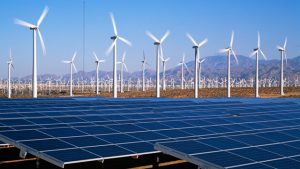As the globe struggles with climate change, sustainability has emerged as a crucial area of concern for all industries. Tech behemoths like Apple, Google, Amazon, Microsoft, and Facebook are among the most significant figures spearheading the shift towards a more environmentally friendly future. These businesses, whose names have come to represent cutting-edge invention, are now making significant investments in renewable energy sources thanks to their enormous financial resources and widespread influence. They are not only lessening their carbon footprints but also establishing a standard that other companies can follow by doing this.
We’ll look at how big IT businesses are funding renewable energy, why they’re doing it, and how this is affecting the world’s transition to a more sustainable economy in this blog post.

- The Motivations for Investing in Renewable Energy
Prior to delving into the particular projects, it’s critical to comprehend the main forces motivating IT businesses’ quest for renewable energy.a. Objectives for Environmental and Corporate Responsibility
Numerous tech firms are aware of their obligation to address environmental degradation and fight climate change. These companies use enormous quantities of energy because of their huge worldwide operations, computer centers, and manufacturing processes. As a result, they have pledged to lessen their carbon footprints, with a number of the biggest digital companies establishing audacious net-zero carbon targets. For example, Amazon wants to attain net-zero carbon across all of its operations by 2040, and Microsoft has committed to becoming carbon-negative by 2030. These objectives support international efforts to keep warming to 1.5°C over pre-industrial levels, as described in the Paris Agreement.
b. Economy of Cost and Originality
Investing in renewable energy has major financial advantages in addition to sustainability. The declining cost of solar, wind, and battery technologies has made renewable energy a financially viable substitute for fossil fuels. In actuality, a lot of tech companies are discovering that it is less expensive to create their own renewable energy infrastructure or to buy clean energy through long-term contracts than it is to rely on conventional power grids.
Investments in renewable energy also encourage innovation. Proprietary technologies have been developed by Google and Amazon, among other companies, to optimise energy usage in their massive data centers. This has increased efficiency while reducing the companies’ need on non-renewable resources.
c. Pressure from stakeholders and reputation
Consumers, investors, and regulators are putting more and more pressure on IT companies to implement more environmentally friendly practices. Environmental, social, and governance (ESG) factors are becoming more important to investors, and consumers are favouring brands that put the environment first. Tech companies are gaining credibility as leaders in sustainability by going green, and investing in renewable energy is not simply a moral choice but also a calculated financial strategy.

- How Tech Giants Are Driving the Green Energy Revolution
Let’s now examine the investments made in renewable energy by some of the biggest tech businesses and the specifics of their programs.a. Google is the first major corporation to use 100% renewable energy.
Google has been at the forefront of renewable energy, with the ambitious goal of using clean energy to power all of its activities worldwide. Google was the first significant business to purchase 100% of the renewable energy it used to power its operations in 2017. To reach this milestone, the company made significant purchases of solar and wind energy to offset the energy used by its offices and data centers across the globe.
Beyond balancing its electricity use, Google’s current goal is to run its operations entirely on carbon-free energy by 2030. This is a more difficult objective than simply balancing energy usage because it entails employing clean energy for all of its operations, every hour of every day. In order to do this, Google is investing in local renewable energy projects all over the world, collaborating with energy storage technologies, and using artificial intelligence (AI) to optimise energy use.
b. Amazon: The Biggest Corporate Buyer of Renewable Energy Worldwide
Another significant investor in renewable energy is Amazon. The corporation has pledged to reaching net-zero emissions by 2040 as part of its Climate Pledge. Amazon’s substantial global expenditures in renewable energy projects are a key component of this endeavour.
With approximately 232 renewable energy projects, including 85 utility-scale solar and wind projects and 147 rooftop solar installations on fulfilment and sorting centers, Amazon emerged as the largest corporate user of renewable energy in 2020. Each year, the energy produced by these plants exceeds 10 gigawatts (GW), which is sufficient to power millions of households.
Additionally, five years ahead of its original 2030 aim, Amazon has declared a goal to run all of its global infrastructure on 100% renewable energy by 2025. throughout order to help in this endeavor, Amazon is constructing wind and solar farms throughout Asia, North America, and Europe as well as investing in state-of-the-art energy storage technologies to control the intermittent production of renewable energy.
c. By 2030, Apple’s supply chain will be carbon neutral.
Apple has consistently positioned itself as a pioneer in environmental sustainability, and this dedication is evident in the company’s investments in renewable energy. 2018 saw Apple meet its objective of using only renewable energy to power all of its global facilities, including offices, data centers, and retail shops. But the company’s goals go well beyond what it does for profit.
Apple wants to achieve carbon neutrality throughout its whole global supply chain and product lifetime by 2030. This indicates that Apple is encouraging its suppliers to embrace clean energy solutions in addition to using exclusively renewable energy for its own needs. Through its Supplier Clean Energy Program, Apple has already convinced over 70 suppliers to convert to renewable energy.
In an effort to further lessen its environmental effect, Apple is investigating the use of low-carbon materials in its manufacturing process. It has also made investments in significant renewable energy projects throughout the world, such as solar farms in China, Denmark, and the United States.
d. Microsoft: By 2030, achieve carbon neutrality
Microsoft has possibly the most ambitious environmental aim among computer corporations. Microsoft intends to achieve carbon neutrality by 2030, which means it will absorb more carbon from the environment than it releases. Beyond this, Microsoft wants to eliminate every carbon gramme the corporation has ever released since its establishment in 1975 by the year 2050.
Microsoft is making significant investments in carbon removal and renewable energy technology in order to achieve these goals. It has already committed to buying more than 1.5 GW of solar and wind energy, and it is switching all of its data centers—which account for most of its energy use—to renewable energy.
Microsoft is also dedicated to assisting other businesses in lowering their carbon footprints by leveraging its cloud computing and AI platforms. Businesses may use Microsoft Cloud for Sustainability to track and optimise their energy and carbon emissions with data-driven tools.
e. Facebook (Meta): All Global Operations Run on 100% Renewable Energy
By 2020, Facebook (now Meta) will have completely switched to renewable energy for all of its businesses worldwide. The business made investments in solar and wind energy projects around Europe and the US to achieve this. Facebook now holds contracts for more than 6 GW of wind and solar electricity, making it one of the biggest corporate purchasers of renewable energy globally.
In the future, Facebook wants to increase the energy efficiency of its data centers, which are infamous for requiring a lot of energy to run because of the demands of maintaining massive social media networks. Facebook uses artificial intelligence (AI) to optimise cooling systems and lower energy use in its newest data centers, making them some of the greenest in the world.

- The broader Effect of Tech Giants’ Investing in Renewable Energy
The enormous sums of money that the tech sector has invested in renewable energy have far-reaching effects that go beyond their daily operations. How these initiatives are impacting future sustainability initiatives and the larger market are as follows:
a. Reducing the Price of Renewable Energy
The cost of solar and wind power is decreasing as a result of the billions of dollars that digital giants like Amazon and Google are investing in renewable energy projects. This makes these energy sources more accessible to both individuals and companies. This growing demand is hastening the move away from fossil fuels by stimulating more research and development as well as investment in renewable energy technology.
b. Motivating Different Industries
The tech sector’s leadership in renewable energy is also setting an example for other industries. Companies are more willing to implement such policies when they observe the financial savings, environmental advantages, and improvements to their brand that result from investing in renewable energy. In order to scale global sustainability efforts across several industries, this ripple effect is essential.
c. Establishing an Ecosystem for Sustainable Energy
Apart from diminishing their personal carbon footprints, technology firms are striving to construct sustainable energy networks that are advantageous to all. Tech companies are leveraging their resources and influence to expedite the global shift towards renewable energy. This includes working together on grid modernisation projects and creating open-source tools that assist other businesses in tracking their carbon emissions.
Conclusion
Tech companies are investing heavily in renewable energy, which is essential for both leading the worldwide shift to a cleaner, greener future and accomplishing their lofty sustainability targets. Businesses such as Google, Amazon, Apple, Microsoft, and Facebook are defining the norm for corporate social responsibility and proving that environmental protection and commercial success can coexist.

